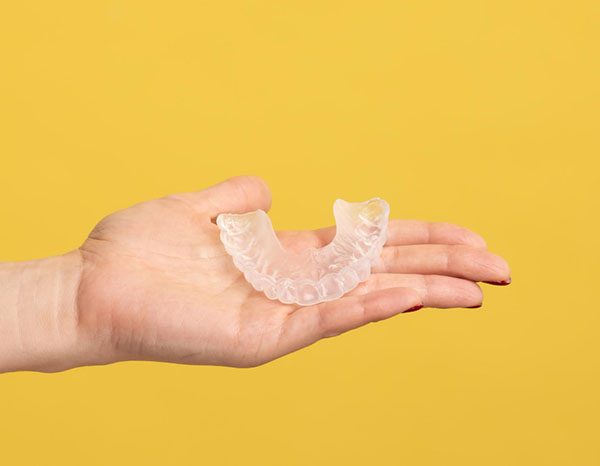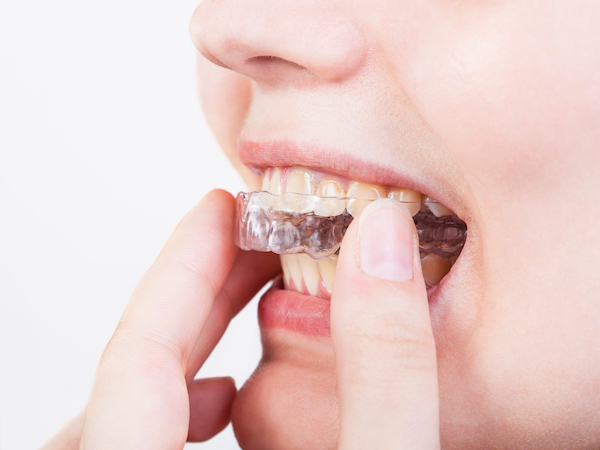Occlusal Splints
Occlusal Splints

Occlusal Splints Cabramatta
For those who grind their teeth, have a history of pain and dysfunction in their bite or temporomandibular joints (TMJ), or have undergone full mouth rehabilitation, occlusal splints are mouthguards that are specifically designed for them.
This precise, custom-made orthotic appliance supports the TMJ and the chewing muscles and guards the teeth against damaging habits.
In what ways does a splint aid?
To create a perfectly even bite, prevent tooth wear, and lessen damaging forces on the jaw joints, ligaments, and cartilage, the splint is made specifically for you on models of your teeth using a chewing simulator.
Splints: Night Guards During Sleep
Teeth grinding or clenching while you sleep, or bruxism is a common issue. It is an unconscious habit that occurs while you sleep, but this may go unnoticed for a while.
Consult your Cabramatta dentist if you experience TMJ pain, sensitive teeth, recurrent headaches, tooth erosion, flat teeth, or damage to your teeth or dental restorations.
A removable appliance called an occlusal splint, known as a “night guard”, is made specifically to fit your top or bottom teeth. It is worn at night to prevent clenching or to grind on your teeth.
Teeth wear and tear from teeth clenching or grinding can result in many instances of cracked teeth.
Cracked teeth can frequently necessitate more expensive dental procedures, such as crowns and root canal therapy, or in more extreme circumstances, tooth removal.
Your teeth experience less pressure when you wear an occlusal splint at night, which also shields them from long-term harm.
The following are typical signs of nighttime grinding or clenching:
- Waking up worn out
- Headaches and stiff neck upon waking
- Waking up with sore teeth
- Having difficulty chewing your breakfast because of sore muscles on the side of your face
How Occlusal Splints Work

Occlusal splints protect the upper teeth’s chewing surfaces. They won’t stop you from clenching or grinding. It is designed to be worn while you sleep.
However, they help to bring the jaw into a neutral position, relieving some of the strain on the jaw joint and safeguarding your teeth from the damaging effects of bruxism.
Your Appointment for an Occlusal Splint
Two quick appointments are typically necessary when creating occlusal splints:
Initial consultation
Your Cabramatta dentist will measure and take impressions of your upper and lower teeth during this appointment.
Next appointment
Your Cabramatta dentist will now fit your new splint to ensure that it fits snuggly over your upper teeth and into your bite.
Occlusal Splints in Cabramatta Dental Care
Oral splints may be the proper treatment for you if you have TMJ disorder or believe you have bruxism. Make an appointment with your Cabramatta dentist right away.
At Cabramatta Dental Care, we take a gentle and meticulous approach to looking after our patients.
Visit your Cabramatta dentist today!
Call us at (02) 9755 5300 to learn more about occlusal splints in Cabramatta, or make an appointment online.
We are located at 47 Arthur St in Cabramatta.
FREQUENTLY ASKED QUESTIONS
What is an occlusal splint?
An occlusal splint, an orthodontic device, is a custom-made mouthguard for people who grind or clench their teeth. These people may also have a history of bite or temporomandibular joint pain and dysfunction (TMJ).
What are occlusal splints made from?
Occlusal splints are mostly made of acrylic. Most splints are clear, making them less noticeable when worn.
When are occlusal splints worn?
The majority of occlusal splints are worn while you sleep. Like when you sleep, you may unintentionally grind your teeth and find it difficult to stop.
Wearing your splint while working or studying is an option as well.
How do I care for my occlusal splint?
Maintaining your occlusal splint will help you get the most benefit from it and make sure it lasts as long as possible.
Here at Cabramatta Dental Care, we advise you to:
- Always use cold water to wash your splint.
- Clean it before and after wearing
- When not in use, keep it in its container.
When your splint is given to you, your dentist in Cabramatta will provide you with additional guidance on how to take care of it.
